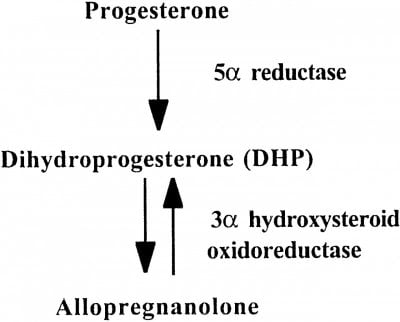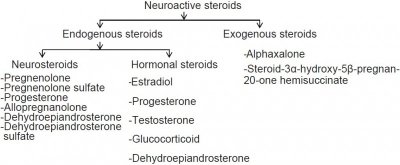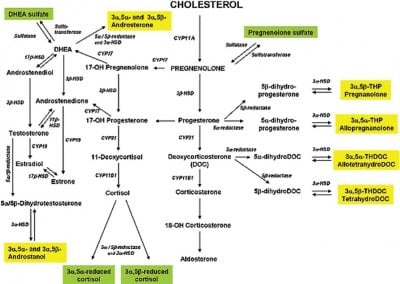You are using an out of date browser. It may not display this or other websites correctly.
You should upgrade or use an alternative browser.
You should upgrade or use an alternative browser.
How Can I Increase My Allopregnanolone ?
- Thread starter Roccc
- Start date
Nelson Vergel
Founder, ExcelMale.com

Metabolism of progesterone. Progesterone (P) is metabolized into allopregnanolone (A), a neuroactive steroid, in 2 steps.
Source: http://ajpregu.physiology.org/content/278/3/R684
Anything that increases 5 alpha reductase (the same enzyme that converts testosterone to DHT) activity may increase allopregnanolone. HCG increases 5 alpha reductase. But be careful (read info below).
I got this info from wikipedia:
Allopregnanolone possesses a wide variety of effects, including, in no particular order, antidepressant, anxiolytic, stress-reducing, rewarding, prosocial, antiaggressive, prosexual, sedative, pro-sleep, cognitive and memory-impairing, analgesic, anesthetic, anticonvulsant, neuroprotective, and neurogenic effects.
Fluctuations in the levels of allopregnanolone and the other neurosteroids seem to play an important role in the pathophysiology of mood, anxiety, premenstrual syndrome, catamenial epilepsy, and various other neuropsychiatric conditions.
Increased levels of allopregnanolone can produce paradoxical effects, including negative mood, anxiety, irritability, and aggression. This appears to be because allopregnanolone possesses biphasic, U-shaped actions at the GABA A receptor; moderate level increases inhibit the activity of the receptor, while lower and higher concentration increases stimulate it. This seems to be a common effect of many GABA receptor positive allosteric modulators. In accordance, acute administration of low doses of micronized progesterone (which reliably elevates allopregnanolone levels), have been found to have negative effects on mood, while higher doses have a neutral effect.
Exogenous progesterone, such as oral progesterone, elevates allopregnanolone levels in the body with good dose-to-serum level correlations.[57] Due to this, it has been suggested that oral progesterone could be described as a prodrug of sorts for allopregnanolone.[57] As a result, there has been some interest in using oral progesterone to treat catamenial epilepsy,[58] as well as other menstrual cycle-related and neurosteroid-associated conditions. In addition to oral progesterone, oral pregnenolone has also been found to act as a prodrug of allopregnanolone,[59][60][61] though also of pregnenolone sulfate.[62]
Note: TRT shuts down LH which is essential in the production of pregnenolone and progesterone.
Anabolic steroids and TRT decrease SHBG, DHEA, pregnenolone and progesterone in men.
Last edited:
Nelson Vergel
Founder, ExcelMale.com
Finasteride affects 5 alpha reductase.
The influence of low dose finasteride, a type II 5-alpha-reductase inhibitor, on circulating neuroactive steroids
Hormone Molecular Biology and Clinical Investigation. Volume 1, Issue 2, Pages 95;102
Abstract
Background: Finasteride is a 5-alpah-reductase inhibitor that has received clinical approval for the treatment of human benign prostatic hyperplasia and androgenetic alopecia. The treatment is practically without side effects, although some occasional cases of depression syndrome have been reported. 5-alpha-Reductase is an enzyme responsible for the reduction of testosterone, progesterone or deoxycorticosterone to their 5 alpha-reduced derivatives possessing anticonvulsant, antidepressant, and anxiolytic activity. Therefore, the formation of GABAergic neuroactive steroids is likely to be impacted by finasteride.
Objective: The objective of the study was to show how the treatment of premature androgenetic alopecia with low doses (1 mg/day) of finasteride influences the broad spectrum of steroids with potential neuroactivity.
Methods: A group of 12 men with premature androgenetic alopecia participated in the present study. The steroid hormone profile was determined for all individuals. Finasteride was administered for 4 months at a daily dose of 1 mg. After the treatment, the same hormonal profile was determined again.
Results: 5-alpha-Reduced steroids, e.g., 5-alpha;-dihydrotestosterone, androsterone, epiandrosterone, 5-alpha-androstenedione, allopregnanolone, isopregnaolone, and some 5-ene steroids, such as dehydroepiandrosterone and pregnenolone, decreased gradually during treatment.
Conclusions: The decrease of 5-alpha-reduced steroids, especially of allopregnanolone, dihydrotestosterone, and pregnenolone, is probably one of the factors responsible for the increased occurrence of depression in men treated with finasteride, even at low doses.
The influence of low dose finasteride, a type II 5-alpha-reductase inhibitor, on circulating neuroactive steroids
Hormone Molecular Biology and Clinical Investigation. Volume 1, Issue 2, Pages 95;102
Abstract
Background: Finasteride is a 5-alpah-reductase inhibitor that has received clinical approval for the treatment of human benign prostatic hyperplasia and androgenetic alopecia. The treatment is practically without side effects, although some occasional cases of depression syndrome have been reported. 5-alpha-Reductase is an enzyme responsible for the reduction of testosterone, progesterone or deoxycorticosterone to their 5 alpha-reduced derivatives possessing anticonvulsant, antidepressant, and anxiolytic activity. Therefore, the formation of GABAergic neuroactive steroids is likely to be impacted by finasteride.
Objective: The objective of the study was to show how the treatment of premature androgenetic alopecia with low doses (1 mg/day) of finasteride influences the broad spectrum of steroids with potential neuroactivity.
Methods: A group of 12 men with premature androgenetic alopecia participated in the present study. The steroid hormone profile was determined for all individuals. Finasteride was administered for 4 months at a daily dose of 1 mg. After the treatment, the same hormonal profile was determined again.
Results: 5-alpha-Reduced steroids, e.g., 5-alpha;-dihydrotestosterone, androsterone, epiandrosterone, 5-alpha-androstenedione, allopregnanolone, isopregnaolone, and some 5-ene steroids, such as dehydroepiandrosterone and pregnenolone, decreased gradually during treatment.
Conclusions: The decrease of 5-alpha-reduced steroids, especially of allopregnanolone, dihydrotestosterone, and pregnenolone, is probably one of the factors responsible for the increased occurrence of depression in men treated with finasteride, even at low doses.
Nelson Vergel
Founder, ExcelMale.com

"Neurosteroids regulate physiological functions of the central nervous system (CNS) and help in the neurodevelopmental functions relating to their neuroprotective effects in brain injury and possible therapeutic potential in brain lesions and other diseases of the nervous system. Neurosteroids have been shown to affect neuronal excitability via their interaction with the ligand-gated ion channel family, such as the GABA [SUB]A[/SUB] and 5-HT [SUB]3[/SUB] receptors, by acting genomically as well as nongenomically. By virtue of these properties, neurosteroids appear to be relevant to pathophysiology and pharmacological treatment of many psychiatric disorders, including not only the notable mood and anxiety disorders, but also psychotic disorders, childhood dementia and stress disorders. They have also been found to be involved in the pathophysiology and treatment of epilepsy, alcohol and substance abuse."

Source
fitnessguy
Member
Has anyone supplemented with 5a-DihroProgesterone?
Yes wouldn't this make sense to supplement with that or progesterone if one was taking a DHT blocker? It kind of seems like it should be common protocol to take with.
Vince Carter
Banned
Yes wouldn't this make sense to supplement with that or progesterone if one was taking a DHT blocker? It kind of seems like it should be common protocol to take with.
What kind of DHT Blocker? There'd be a real difference in say SawPalmetto, and Finasteride.
fitnessguy
Member
What kind of DHT Blocker? There'd be a real difference in say SawPalmetto, and Finasteride.
Finasteride
Nelson Vergel
Founder, ExcelMale.com

Allopregnanolone: An overview on its synthesis and effects
Abstract Allopregnanolone, a 3α,5α-progesterone metabolite, acts as a potent allosteric modulator of the γ-aminobutyric acid type A receptor. In the present review, the synthesis of this neuroactive steroid occurring in the nervous system is discussed with respect to physiological and...
Nelson Vergel
Founder, ExcelMale.com

Allopregnanolone in mood disorders
ABSTRACT The neuroactive steroid allopregnanolone (ALLO) is an endogenous positive allosteric modulator of GABA type A receptor (GABAAR), and the down-regulation of its biosynthesis has been attributed to the development of mood disorders, such as depression, anxiety, and post-traumatic stress...
Nelson Vergel
Founder, ExcelMale.com

TRT Effect on 5 Alpha Reductase and Upstream Hormones- Cause of Low Mood and Anxiety?
In this video dr Mark Gordon, starting at 9min, explains how using good level of TRT can "burn" 5 alpha reductase enzyme, that beside being responsible for converting Test into DHT, it is also responsible for converting Progesterone into Allopregnanolone in the brain. Throughout the years on...
Nelson Vergel
Founder, ExcelMale.com
Drug that increases allopregnanolone:

 www.excelmale.com
www.excelmale.com

Evaluating brexanolone for the treatment of PostPartum Depression
ABSTRACT Introduction: Postpartum depression (PPD) is a serious and common complication of childbirth that can have deleterious effects not only on the mother but on the cognitive and behavioral development of exposed children. Brexanolone is a novel, soluble synthetic formulation of the...
Nelson Vergel
Founder, ExcelMale.com

Pregnenolone and Progesterone for Men: Pharmacokinetics and Studies
That guys body is probably irreparably damaged. This blows my mind. Has he ever gotten bloodwork? I don’t think so, sad to see. But for now he feels like Zeus apparently. Talking to and watching this guy was an interesting experience. Quite entertaining honestly. Alpha to the max haha. He was...
Nelson Vergel
Founder, ExcelMale.com
Allopregnanolone Elevations Following Pregnenolone Administration are Associated with Enhanced Activation of Emotion Regulation Neurocircuits - PMC
The neurosteroid allopregnanolone is a potent allosteric modulator of the GABA(A) receptor with anxiolytic properties. Exogenous administration of allopregnanolone reduces anxiety, and allopregnanolone blockade impairs social and affective ...
Background
The neurosteroid allopregnanolone is a potent allosteric modulator of the GABA(A) receptor with anxiolytic properties. Exogenous administration of allopregnanolone reduces anxiety, and allopregnanolone blockade impairs social and affective functioning. However, the neural mechanism whereby allopregnanolone improves mood and reduces anxiety is unknown. In particular, brain imaging has not been used to link neurosteroid effects to emotion regulation neurocircuitry.
Methods
To investigate the brain basis of allopregnanolone’s impact on emotion regulation, participants were administered 400mg of pregnenolone (N=16) or placebo (N=15) and underwent 3T fMRI while performing the Shifted-Attention Emotion Appraisal Task (SEAT), which probes emotional processing and regulation.
Results
Compared to placebo, allopregnanolone was associated with reduced activity in the amygdala and insula across all conditions. During the appraisal condition, allopregnanolone increased activity in the dorsal medial prefrontal cortex and enhanced connectivity between the amygdala and dorsal medial prefrontal cortex, an effect that was associated with reduced self-reported anxiety.
Conclusions
These results demonstrate that in response to emotional stimuli, allopregnanolone reduces activity in regions associated with generation of negative emotion. Furthermore, allopregnanolone may enhance activity in regions linked to regulatory processes. Aberrant activity in these regions has been linked to anxiety psychopathology. These results thus provide initial neuroimaging evidence that allopregnanolone may be a target for pharmacological intervention in the treatment of anxiety disorders, and suggest potential future directions for research into neurosteroid effects on emotion regulation neurocircuitry.
Nelson Vergel
Founder, ExcelMale.com
To investigate the pharmacokinetics of progesterone, allopregnanolone and pregnanolone after treatment with a low oral dose of progesterone. Eight postmenopausal women were given a single oral dose of 20 mg of micronised progesterone on Day 1 and 20 mg twice daily on Days 2-7. Blood samples for the analysis of progesterone, allopregnanolone and pregnanolone were collected, and pharmacokinetic parameters were calculated. After ingestion of a single dose, areas under the plasma concentration-time curve (AUC) from 0 to 12 h for progesterone, allopregnanolone and pregnanolone were 127%, 196% and 119% higher than the corresponding AUCs estimated to be caused by endogenous production. The maximum plasma concentration (Cmax) and the AUC values were significantly lower for pregnanolone than for progesterone and allopregnanolone. The trough concentrations at steady state (Css) were significantly higher than the baseline values, and Css for pregnanolone was significantly lower than for allopregnanolone and progesterone. Css for allopregnanolone was in the range of what is normally seen in the menstrual cycle. After ingestion of a low-dose of progesterone, the concentrations of allopregnanolone were in the same range as those of progesterone. Oral doses of 20 mg of progesterone twice daily to postmenopausal women produced allopregnanolone concentrations comparable to those achieved physiologically in premenopausal women. Low-dose oral progesterone may be used as a prodrug to allopregnanolone when the aim is to investigate low-dose allopregnanolone effects in humans.

 www.researchgate.net
www.researchgate.net

(PDF) Pharmacokinetics of progesterone and its metabolites allopregnanolone and pregnanolone after oral administration of low-dose progesterone
PDF | To investigate the pharmacokinetics of progesterone, allopregnanolone and pregnanolone after treatment with a low oral dose of progesterone. Eight... | Find, read and cite all the research you need on ResearchGate
Online statistics
- Members online
- 3
- Guests online
- 5
- Total visitors
- 8
Totals may include hidden visitors.
© Copyright ExcelMale
















